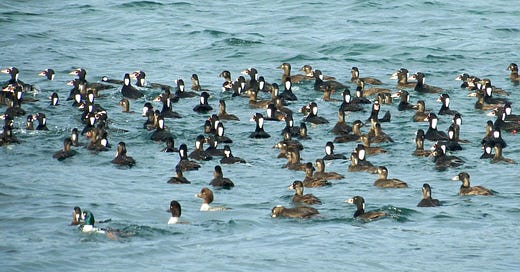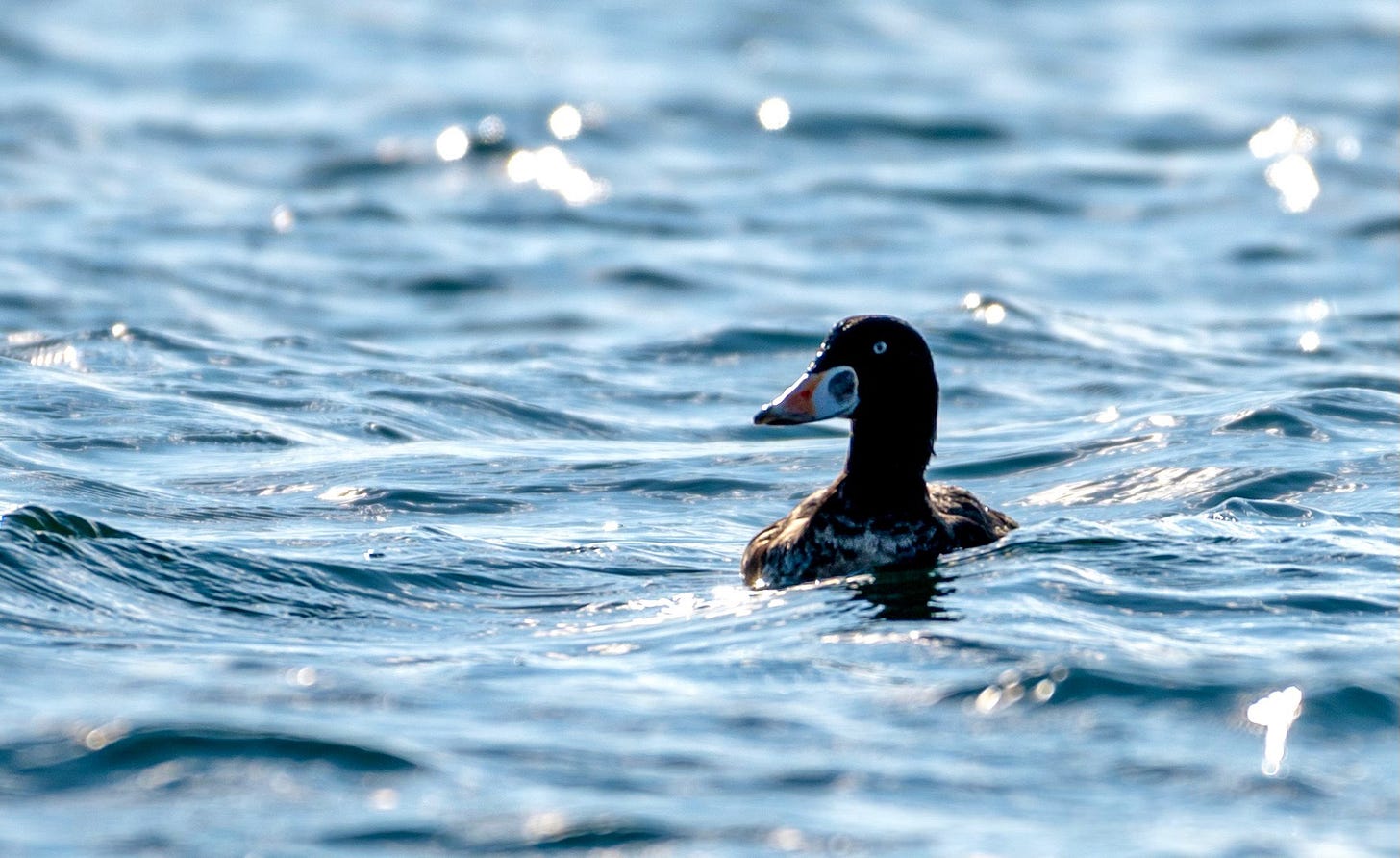Pause on the Purdy Spit. Look on the lagoon side. What do you see? A rambunctious crew of surf scoters, hundreds strong, bouncing around like bumper cars.

Surf scoters are migratory sea ducks. They are only here in the colder months. A male surf scoter, black all over, is instantly recognized by its goofy orange-and-white beak and a white neck patch that is vaguely mullet-like. The female’s beak is similarly chunky, but it matches her body’s dark ashy gray.
See them dive. Without warning, one cocks its wings at a severe angle and throws itself head-first into the water. The rest of its crew, seeming afraid to miss out on the action, follows suit. Sometimes the now-empty water roils with their underwater adventures. Then up they come, bumping and biting at tails. They are the definition of unsynchronized. Maybe one in twenty has a clam or crab in its beak and promptly swallows it whole, before the others notice.
Shellfish have long been considered a surf scoter’s favorite food. The ducks congregate over sandy areas for clams and rocky reefs for mussels. Watch the Burley scoters and you’ll see. The shellfish industry stakes nets over its harvests.
Recent research, however, suggests that past studies of the surf scoter diet have exaggerated the shellfish component. It makes sense. If the tools at your disposal, as a researcher, are observation and the inspection of a scoter’s gizzard, where hard food is ground to pieces, you’ll mostly note large, hard prey items. In fact, surf scoters have a wide-ranging palate that has them seeking out a variety of soft-bodied sea creatures, small crabs, marine snails, marine worms, even vegetation.
The past studies are probably also a reflection of the way we sit up and take notice when an animal eats something we want to eat, like a clam.
Surf scoters occasionally decamp from their usual haunts, like gold rushers on a stampede, to plunder the sort of massive food pile that can sometimes appear in the sea.
In the spring of 2003, researchers in British Columbia, following scoters to a place where they had gathered in a great frenzy, dispatched a diver who found “a large continuous gelatinous matrix…surrounded by loose decaying algae,” according to the report published in Marine Ornithology in 2005. Embedded in the mass of gel were millions of young polychaete worms.
The scoters were feasting. A gray whale joined. Little is known about the species of polychaete worm involved, except that when it goes to breed, it gathers en masse to join mucous tunnels into huge net-like structures that aim to overwhelm predators with abundance, like an oak that suddenly drops thousands of acorns.
A more common bonanza for surf scoters is herring spawn.
Up and down the northwest coast each spring, herring stocks synchronize their egg-laying. One morning, all at once, just below the low-tide line, billions of herring eggs will coat every rock, branch and blade of algae. The eggs last two weeks before they hatch and are gone. Scoters go wild for them.
In the south Puget Sound, where herring numbers are at a fraction of their historical abundance, we have recently been treated to a glimpse of this phenomenon.
A Purdy stock breeds both inside and outside the lagoon. It had a banner year in 2023. The Washington Department of Fish and Wildlife estimated 3,031 metric tons of herring spawn at Purdy. The previous high in 16 years of monitoring was 884 metric tons.
Herring spawn is one of the key indicators used by Puget Sound Vital Signs, a multi-agency effort to track Puget Sound’s overall health.
The herring trends have been mixed. Unlike elsewhere in the Pacific, Puget Sound stocks overlap geographically and spawn throughout a six-month window, and when numbers go up in one area they often go down in another.
That the bonanza swirls unpredictably was actually a boon to indigenous people in the Northwest. The genetic diversity of herring, like that of salmon, creates a more varied food landscape in an ecosystem where individual stocks often boom and bust. Diversity is a form of security.
A Vashon Island archeological site had 10 herring bones for every salmon bone. Salmon get the press, but herring were just as important to the Nisqually and Puyallup peoples, who raked adult herring from the sea and dried and smoked them in great numbers. At spawning time, tribal members blanketed the tide flats with cedar boughs. When the boughs were covered with eggs, they pulled them in and feasted and dried basketfuls for storage.
In British Columbia, anthropologist Franz Boaz found Kwakiutl people using herring spawn to bait traps that were anchored underwater to catch sea ducks. Scoters were probably on the menu, given their love of herring spawn.
Around Purdy, scoter numbers shift from year to year. Data from eBird suggests that surf scoters have declined by about 10% in the past decade in the South Sound. Their close cousins, white-winged scoters, have declined 30–40%. For birders, Burley Lagoon has traditionally been the best place in spring to see a rare black scoter mixed in with the surf scoters.
When you go to see the scoter flock, watch for the “scoter salute”—a scoter when it comes in for landing on the water lifts its wings briefly to the sky as it skids to a stop.
Endnotes
In the Salish Sea, abandoned underwater fishing nets and crab pots kill scoters and many other sea creatures. A 2010 study of 870 derelict gillnets that had been removed by a team of agencies found 76 species of invertebrates, 22 species of fish, 16 species of birds, and 4 species of mammals trapped in the nets. Derelict gillnets are concentrated around the San Juan Islands and North Puget Sound, where rocky reefs are common.
For more on herring in the Salish Sea, see this essay by David B. Williams in the Encyclopedia of Puget Sound.
Thanks for reading Infinite Peninsula. Subscribe to receive every ramble and adventure, become a paid subscriber to keep me going, and share with anyone who would dig a spy’s-eye view of the world we share with Cascadia critters. Till next time.






I love your reflection - diversity is security - that's definitely something I have noticed within the ecosystems around my home in Wales but also in a wider sense in all areas of life. Here in Cymru/Wales, lower land prices and higher poverty rates than in other parts of the island have meant many small farms traditionally growing a diverse range of crops and keeping a range of animals have been swallowed up into larger monocultures which, of course, has a massive impact on wildlife and on our local food security. I loved learning about the traditional foodways on your peninsula responding to the cycles of the local animals. Those scooters look like real characters! I'm sad to say I haven't ever seen so many ducks hanging out together. Perhaps there might have been at one time, but I don't believe there are any large seabird colonies like this in my area today :(
Thanks for mentioning my article in the Encyclopedia of Puget Sound. It's based on my book Homewaters: A Human and Natural History of Puget Sound. During the research for the book on my chapter on herring, I was lucky to witness them spawning and to see the great rafts of scoters. They are quite fun to watch. As you note, the spawn is happening right now and Hood Canal is a great place to witness this amazing natural history event.